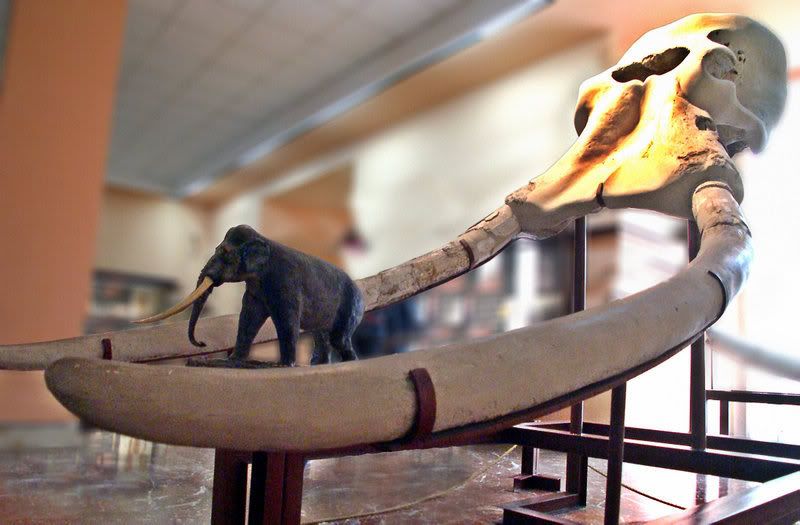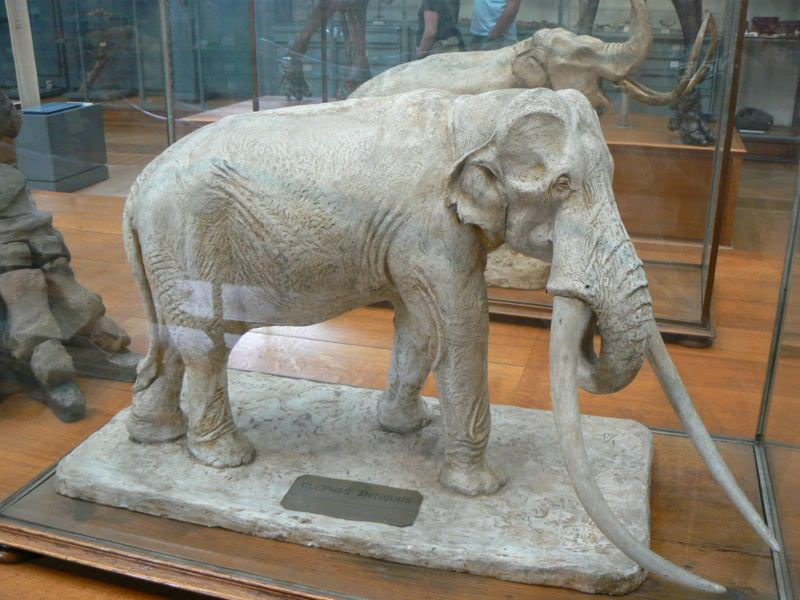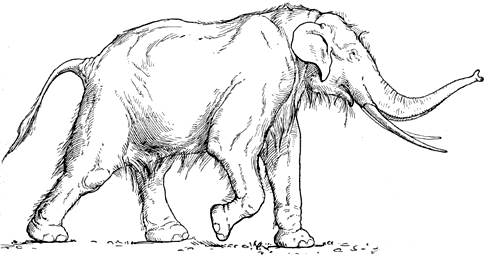Post by another specialist on Dec 24, 2007 17:42:44 GMT
The Straight-tusked Elephant (Elephas (Palaeoloxodon) antiquus or Palaeoloxodon antiquus) is an extinct species of elephant closely related to the living Asian Elephant. It inhabited Europe during the Middle and Late Pleistocene (781,000–11,550 years before present). Some experts regard the smaller Asian species E. namadicus, as a variant or subspecies of this one.
Description
The creature was 3.70 m (12 ft) tall and had long, slightly upward-curving tusks. E. antiquus's legs were slightly longer than those of modern elephants. It is suggested that this elephant had a 80 cm long tongue that could be projected a short distance from the mouth to grasp leaves and grasses. With this tongue along with a flexible trunk, straight-tusked elephants could graze or browse on Pleistocene foliage about 8 meters above ground.
Behavior
Straight-tusked elephants lived in small herds of about 5 to 15 individuals. They preferred warm conditions and flourished in the interglacial periods during the Ice Ages, spreading from continental Europe to Great Britain during the warmer periods. It is assumed that they preferred wooded environments. During colder periods the species migrated south. It became extinct in Britain by the beginning of the last ice age, about 115,000 years ago. Eventually it was replaced by the mammoth.
Excavations
A skull of Elephas antiquus.Finds of isolated tusks are relatively common in the United Kingdom. For example a tusk of this elephant was found during the construction of the Swan Valley Community School in Swanscombe. However, finds of whole or partial skeletons of this elephant are very rare.
Skeleton finds in the United Kingdom are known from only a few sites. Two sites were found in the Lower Thames basin, one at Upnor, Kent and one at Aveley, Essex. Archaeological excavations in advance of High Speed 1 revealed the 400,000 years old skeleton of a straight-tusked elephant in the Ebbsfleet Valley, near Swanscombe, Kent. It was lying at the edge of what would once have been a small lake. Flint tools lay scattered around, suggesting the elephant had been cut up by a tribe of the early humans around at the time, known as Homo heidelbergensis.
On the European mainland many remains of the straight-tusked elephant have been found. A handful of these sites even contain, besides a skeleton, archaeological material like in the Ebbsfleet Valley (England). A skeleton at Lehringen (Germany) was found with the remains of a yew spear between it ribs and lithic artifacts around the head.
Straight-tusked elephant remains have been found with flint tools at a number of sites, such as Torralba and Aridos in Spain, Notarchirico in Italy, Gröbern and Ehringsdorf in Germany.
Dwarfed descendants
Elephants presumably derived from the Straight-tusked Elephant are described from many Mediterranean islands, where they evolved into dwarfed elephants. The responsible factors for the dwarfing of island mammals are thought to be the reduction in food availability, predation and competition.
en.wikipedia.org/wiki/Straight-tusked_Elephant
Description
The creature was 3.70 m (12 ft) tall and had long, slightly upward-curving tusks. E. antiquus's legs were slightly longer than those of modern elephants. It is suggested that this elephant had a 80 cm long tongue that could be projected a short distance from the mouth to grasp leaves and grasses. With this tongue along with a flexible trunk, straight-tusked elephants could graze or browse on Pleistocene foliage about 8 meters above ground.
Behavior
Straight-tusked elephants lived in small herds of about 5 to 15 individuals. They preferred warm conditions and flourished in the interglacial periods during the Ice Ages, spreading from continental Europe to Great Britain during the warmer periods. It is assumed that they preferred wooded environments. During colder periods the species migrated south. It became extinct in Britain by the beginning of the last ice age, about 115,000 years ago. Eventually it was replaced by the mammoth.
Excavations
A skull of Elephas antiquus.Finds of isolated tusks are relatively common in the United Kingdom. For example a tusk of this elephant was found during the construction of the Swan Valley Community School in Swanscombe. However, finds of whole or partial skeletons of this elephant are very rare.
Skeleton finds in the United Kingdom are known from only a few sites. Two sites were found in the Lower Thames basin, one at Upnor, Kent and one at Aveley, Essex. Archaeological excavations in advance of High Speed 1 revealed the 400,000 years old skeleton of a straight-tusked elephant in the Ebbsfleet Valley, near Swanscombe, Kent. It was lying at the edge of what would once have been a small lake. Flint tools lay scattered around, suggesting the elephant had been cut up by a tribe of the early humans around at the time, known as Homo heidelbergensis.
On the European mainland many remains of the straight-tusked elephant have been found. A handful of these sites even contain, besides a skeleton, archaeological material like in the Ebbsfleet Valley (England). A skeleton at Lehringen (Germany) was found with the remains of a yew spear between it ribs and lithic artifacts around the head.
Straight-tusked elephant remains have been found with flint tools at a number of sites, such as Torralba and Aridos in Spain, Notarchirico in Italy, Gröbern and Ehringsdorf in Germany.
Dwarfed descendants
Elephants presumably derived from the Straight-tusked Elephant are described from many Mediterranean islands, where they evolved into dwarfed elephants. The responsible factors for the dwarfing of island mammals are thought to be the reduction in food availability, predation and competition.
en.wikipedia.org/wiki/Straight-tusked_Elephant





